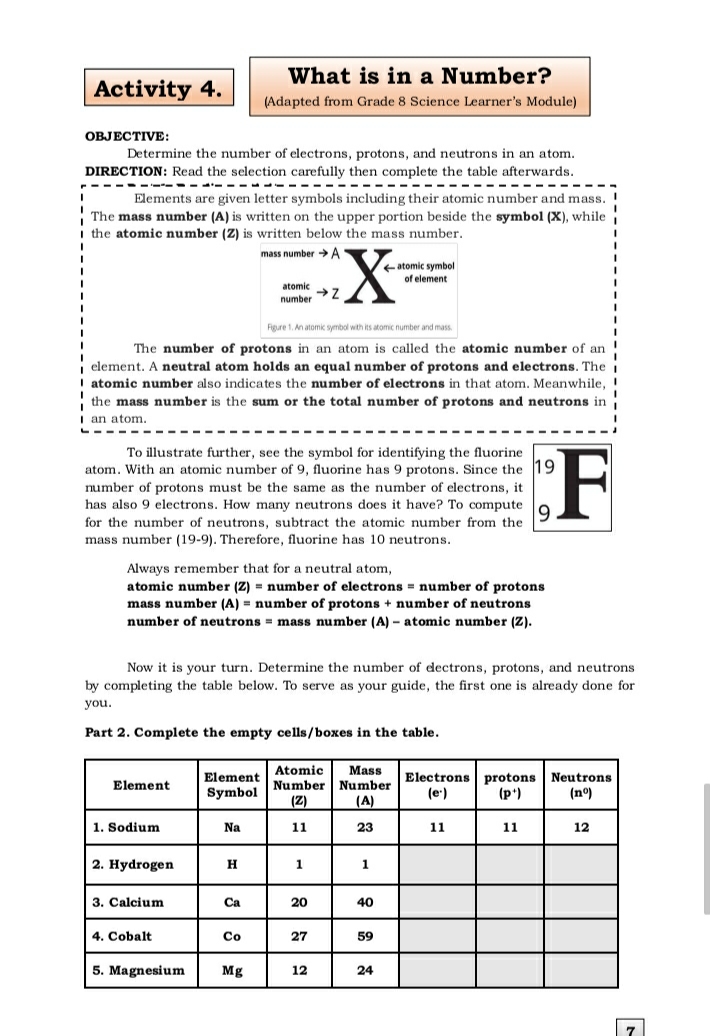Part 2. Complete the empty cells/boxes in the table. Atomic Number Number Mass Electrons protons Neutrons (p') Element Element Symbol (e') (n이 (Z) (A) 1. Sodium Na 11 23 11 11 12 2. Hydrogen 1 1 3. Calcium Ca 20 40 4. Cobalt Co 27 59 5. Magnesium Mg 12 24
Part 2. Complete the empty cells/boxes in the table. Atomic Number Number Mass Electrons protons Neutrons (p') Element Element Symbol (e') (n이 (Z) (A) 1. Sodium Na 11 23 11 11 12 2. Hydrogen 1 1 3. Calcium Ca 20 40 4. Cobalt Co 27 59 5. Magnesium Mg 12 24
Chemistry: The Molecular Science
5th Edition
ISBN:9781285199047
Author:John W. Moore, Conrad L. Stanitski
Publisher:John W. Moore, Conrad L. Stanitski
Chapter1: The Nature Of Chemistry
Section1.13: The Periodic Table
Problem 1.9E
Related questions
Question
100%
answer

Transcribed Image Text:What is in a Number?
Activity 4.
(Adapted from Grade 8 Science Learner's Module)
ОВJЕСTIVE:
Determine the number of electrons, protons, and neutrons in an atom.
DIRECTION: Read the selection carefully then complete the table afterwards.
---- ---
.---
----
Elements are given letter symbols including their atomic number and mass.
The mass number (A) is written on the upper portion beside the symbol (X), while
i the atomic number (Z) is written below the mass number.
X:
mass number A
+ atomic symbol
of element
atomic
number
Figure 1. An atomik symbol with its atomic number and mass.
The number of protons in an atom is called the atomic number of an
element. A neutral atom holds an equal number of protons and electrons. The
I atomic number also indicates the number of electrons in that atom. Meanwhile, !
the mass number is the sum or the total number of protons and neutrons in
I an atom.
F
To illustrate further, see the symbol for identifying the fluorine
atom. With an atomic number of 9, fluorine has 9 protons. Since the 19
number of protons must be the same as the number of electrons, it
has also 9 electrons. How many neutrons does it have? To compute
for the number of neutrons, subtract the atomic number from the
mass number (19-9). Therefore, fluorine has 10 neutrons.
Always remember that for a neutral atom,
atomic number (Z) = number of electrons = number of protons
mass number (A) = number of protons + number of neutrons
number of neutrons = mass number (A) – atomic number (Z).
Now it is your turn. Determine the number of dectrons, protons, and neutrons
by completing the table below. To serve as your guide, the first one is already done for
you.
Part 2. Complete the empty cells/boxes in the table.
Atomic
Mass
Number Number
(Z)
Electrons protons Neutrons
(p)
Element
Element
Symbol
(e')
(nº)
(A)
1. Sodium
Na
11
23
11
11
12
2. Hydrogen
H
1
1
3. Calcium
Ca
20
40
4. Cobalt
Co
27
59
5. Magnesium
Mg
12
24
Expert Solution
This question has been solved!
Explore an expertly crafted, step-by-step solution for a thorough understanding of key concepts.
This is a popular solution!
Trending now
This is a popular solution!
Step by step
Solved in 5 steps

Knowledge Booster
Learn more about
Need a deep-dive on the concept behind this application? Look no further. Learn more about this topic, chemistry and related others by exploring similar questions and additional content below.Recommended textbooks for you

Chemistry: The Molecular Science
Chemistry
ISBN:
9781285199047
Author:
John W. Moore, Conrad L. Stanitski
Publisher:
Cengage Learning

Introductory Chemistry: An Active Learning Approa…
Chemistry
ISBN:
9781305079250
Author:
Mark S. Cracolice, Ed Peters
Publisher:
Cengage Learning

General Chemistry - Standalone book (MindTap Cour…
Chemistry
ISBN:
9781305580343
Author:
Steven D. Gammon, Ebbing, Darrell Ebbing, Steven D., Darrell; Gammon, Darrell Ebbing; Steven D. Gammon, Darrell D.; Gammon, Ebbing; Steven D. Gammon; Darrell
Publisher:
Cengage Learning

Chemistry: The Molecular Science
Chemistry
ISBN:
9781285199047
Author:
John W. Moore, Conrad L. Stanitski
Publisher:
Cengage Learning

Introductory Chemistry: An Active Learning Approa…
Chemistry
ISBN:
9781305079250
Author:
Mark S. Cracolice, Ed Peters
Publisher:
Cengage Learning

General Chemistry - Standalone book (MindTap Cour…
Chemistry
ISBN:
9781305580343
Author:
Steven D. Gammon, Ebbing, Darrell Ebbing, Steven D., Darrell; Gammon, Darrell Ebbing; Steven D. Gammon, Darrell D.; Gammon, Ebbing; Steven D. Gammon; Darrell
Publisher:
Cengage Learning


Chemistry: An Atoms First Approach
Chemistry
ISBN:
9781305079243
Author:
Steven S. Zumdahl, Susan A. Zumdahl
Publisher:
Cengage Learning
